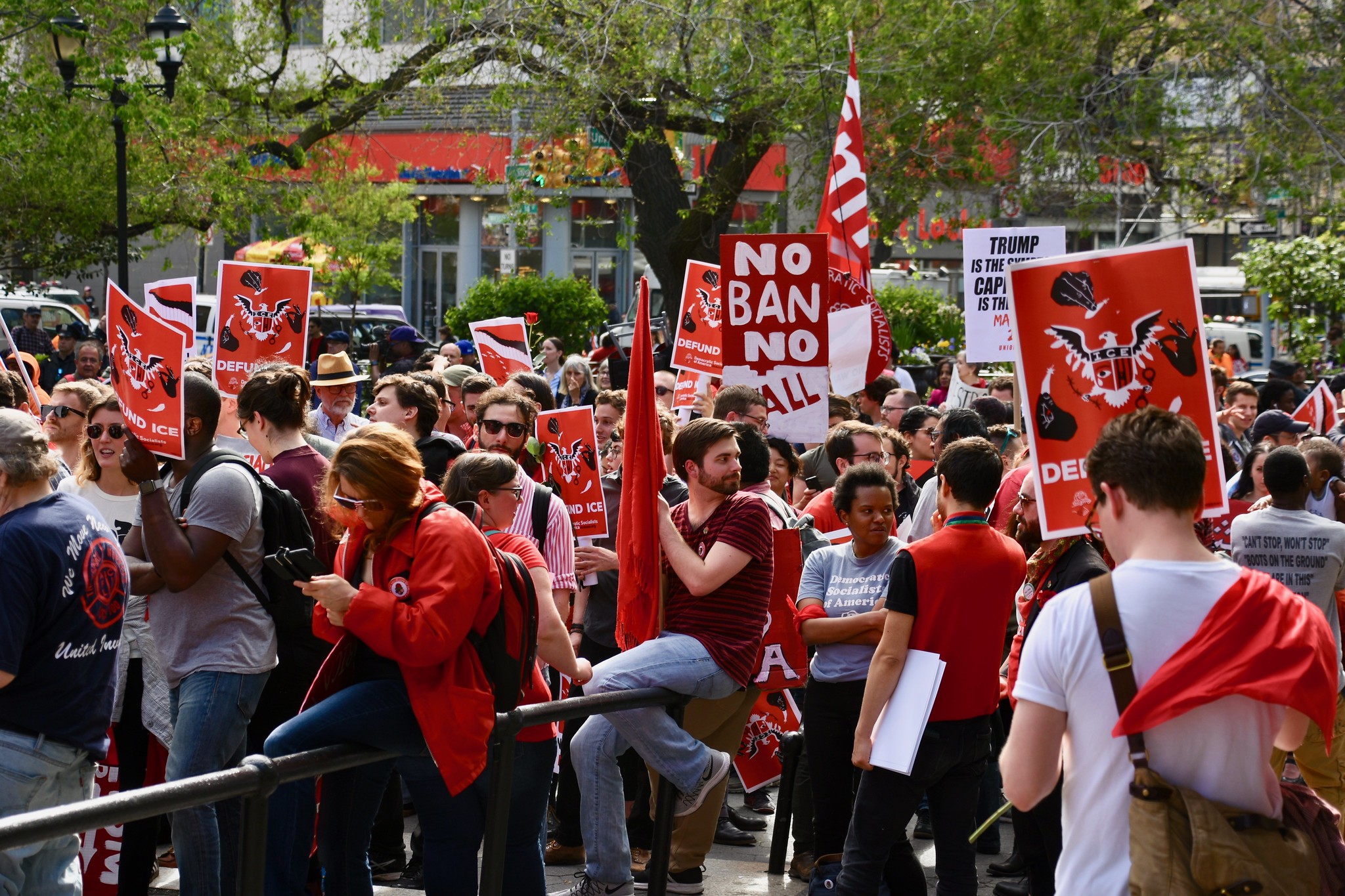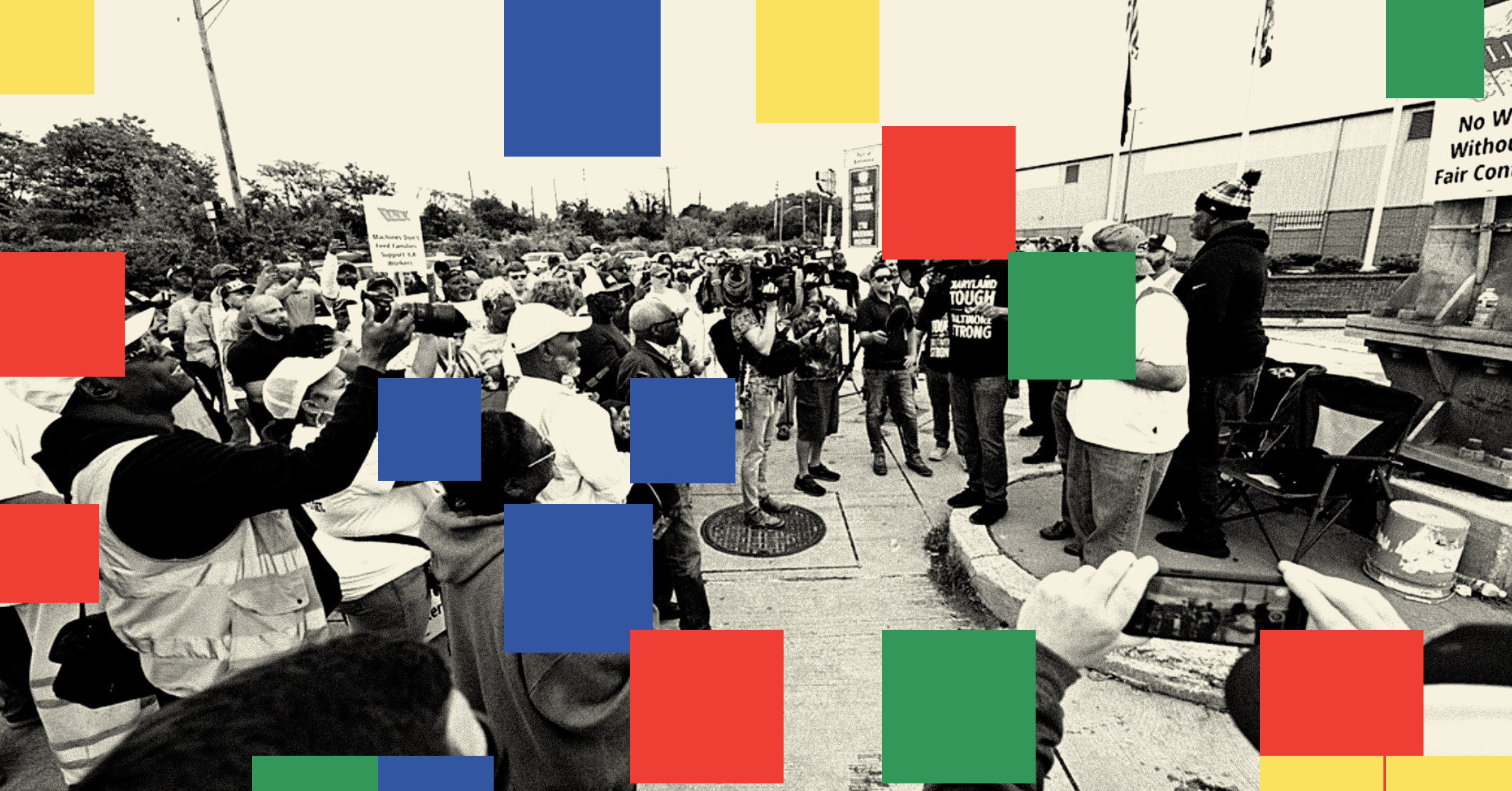At the upcoming NYC-DSA chapter convention on October 22, delegates will have the opportunity to vote on the 1-2-3-4 Plan to Build a Party-Like Structure. This proposal acknowledges that we as democratic socialists can’t build a formally independent party today. And there are some in DSA who do not think a formally independent party should be our goal. But there are steps we can take to build a party-like structure, a goal that many in DSA support across political tendencies.
The 1-2-3-4 Plan outlines some of those steps, and is designed to address two major problems: the problem of visibility, consciousness, and base building and the problem of pushing back against our enemies’ new strategy.
The Problem of Visibility, Consciousness, and Base Building
Travel through many other countries at election time and you’ll know right away who the various parties contending for power are. In Mexico, you’ll see the white and red banners of MORENA and the slogan “la esperanza de México.” In Germany, you’ll see posters with the candidate running in a specific district for Die Linke plus Die Linke’s distinctive brand. In Brazil, you’ll see the red star of the Partido dos Trabalhadores or the yellow sun of the Partido Socialismo e Liberdade.
Parties aggressively broadcast their existence and their positions, and as a result people understand political conflicts as fights between parties. Elections are not reduced to personality contests between individual politicians. They are conflicts between different parties and each party’s strategy. By organizing political conflict in this way, parties elsewhere increase the ability of everyday people to participate meaningfully in political debate and hold parties responsible for their decisions.
Increasingly, the same can be said for the United States — to an extent. The rise of highly polarized politics has presented voters with a stark choice between the far-right Republican Party and the center-right Democratic Party. Candidates are more and more explicit about their identification with each party, and a variety of symbols — brands, ballot lines, etc. — draw these lines more explicitly.
The problem for democratic socialists is that — denied the use of our own ballot line by the U.S.’s two-party system — we do not factor into this conflict as a third clear alternative. Instead of a struggle between the working class and an owning class, politics is framed as a competition between Republicans and Democrats.
We can win some elections, absolutely. But usually we win because people associate us with being the “progressive Democratic” choice. And we win in extremely low-turnout elections, in which a small handful of high-information voters usually decide the outcome.
If our strategy rested on electing a few good people to office and then hoping they can change the world, this might not be a problem. But as democratic socialists, we should be committed to a very different strategy. Only an active movement of tens of millions of people fighting for their needs and wants can change things.
The only way we can build that kind of self-active base is through being explicit about who we are. “We are democratic socialists, we are presenting a different strategy and a different way of doing politics than the way the Democratic Party works. And we want you to join us.” That’s the kind of call to arms we need to be delivering everywhere we go.
Nor do we need to be afraid of identifying as socialists in Democratic Party primaries, especially in urban centers like New York City. Poll after poll shows that Democratic Party voters — and people of color in particular — have positive views of democratic socialism. Bernie and AOC are among the most popular politicians among Democratic voters. This is a unique opportunity to build a self-conscious and proudly socialist base.
It’s crucial that we figure out a way to heighten the visibility of DSA and our status as a party-like organization in all our electoral work. We can’t have our own ballot line, yet. But we can take clear steps to present ourselves to the people as a distinct political force.
The Problem of Our Enemies
We think that the positive argument for building a party-like structure should be a sufficient reason for supporting the 1-2-3-4 Plan. But it happens to be the case that there’s an additional pressing reason why we need to define ourselves in the popular consciousness: if we don’t, our enemies will do it for us.
Last year, New York City Mayor Eric Adams said he was at war with DSA. Adams and his crew of right-wing Democrats know that DSA has the potential to challenge and defeat their wing of the Democratic Party. They want to destroy us. And the best way to do that is by defining DSA as a shadowy and sinister organization. In fact, that’s what they’re already trying to do, with mailers that attack our candidates’ affiliation with DSA.
A good piece of advice is that you have to define yourself or someone else will. In the coming elections, it is urgent that NYC-DSA defines itself in the public consciousness as a positive force fighting for people’s interests and asking them to join us in this struggle. The consequences of hiding our identity, of running from the democratic socialist label and implying that we’re ashamed of it, could be catastrophic.
By clearly identifying as a slate and as DSA, we also distinguish ourselves from progressive Democrats. In many elections, we have and will face the problem of running elections against candidates who claim to be progressives. They run on many of the same issues as us and fudge the difference between being a progressive and being a socialist. By being more vocal about our identity as democratic socialists — in the same way that Bernie and AOC do — and by emphasizing that being part of a slate and a de facto caucus makes us more accountable to our base, we can draw clearer distinctions between us and progressives.
Most importantly, to truly draw a distinction between progressive candidates and DSA, we must highlight how we are independent of the political establishment in ways that they are not. Other candidates can only offer vague forms of accountability, but DSA has a clearly defined process to ensure our elected officals remain accountable on pro-working class issues. Furthermore, our candidates do not operate as individuals, they operate with all of New York City DSA behind them. We are ready to defend them against any attacks that get thrown their way. This means that they can vocally and confidently advocate for working-class demands. For us to keep winning elections, voters must understand that it is democratic socialists, not progressive Democrats, who will best improve their material conditions.
The 1-2-3-4 Plan
So how do we plan to tackle these problems?
We’re proposing the 1-2-3-4 Plan to Build a Party-Like Structure at NYC-DSA’s 2022 chapter convention.
The 1-2-3-4 Plan is pretty straightforward: it stands for one slate, two words, three issues, and four rules.
The one slate provision of the proposal sets the expectation that after our candidates receive NYC-DSA’s endorsement, they will agree to be part of a DSA slate. That means they will coordinate and centralize their comms and design teams, hold a coordinated launch for the slate, and use as much common branding as possible throughout the campaign to tie our candidates together.
Two words means that our candidates should all explicitly, publicly, and prominently identify as “democratic socialists,” including on their literature and mailings and in the scripts they encourage canvassers to use.
Three issues means that our candidates should use a couple shared issues in their campaign (we suggest, but don’t mandate, three issues). These can be decided before each election cycle and might include, for example, rent control, universal healthcare, and/or building public renewables. This part of the proposal does not prevent candidates from running on additional issues specifically relevant to their district, and does not prevent the chapter from changing its focus on particular issues as a campaign evolves.
Finally, the four rules are four expectations for potential candidates to follow. First, it asks them to agree before being considered for endorsement to not run in the district if NYC-DSA endorses another candidate in that race. We’ve had problems with candidates seeking our endorsement and then running as spoilers when they aren’t endorsed. We should never consider a candidate like this. Second, it asks candidates to deemphasize their affiliation with the Democratic Party — though candidates will of course need to say that they are running in the Democratic Party primary. Third, it sets the expectation that they will endorse all other NYC-DSA candidates at the same time as the rest of the slate. And finally, it asks candidates to agree to join the DSA Socialists in Office committee if elected (DSA’s de facto caucus in Albany) and bloc vote with our other socialist politicians.
We believe these steps would meaningfully move us towards a party-like structure in New York City. They would strengthen the unity of our bloc in Albany and allow us to contest elections as a single slate. We would heighten DSA’s visibility and positively define for people what it means to be a DSA candidate.
A Party-Like Structure for the 2020s
DSA has debated for years what kind of electoral machine we’re building. There are some in the organization who insist that we should make a clean break from the Democratic Party today and start our own formal party. We don’t agree with that perspective. There are others who believe that we should build a “party surrogate,” a party in all but name, without a formal ballot line. And there are those, including us, who believe we should be building the structures of a proto-party with the objective of making a “dirty break” from the Democratic Party in the years to come.
Regardless of where you fall in these debates, however, we believe that the 1-2-3-4 Plan deserves your support. If you believe that we need to build a party surrogate, for example, then clear steps to increase the unity of our bloc in Albany and help increase the visibility of DSA as an organization should be extremely desirable.
DSA has come a long way in our electoral work. We have a lot to be proud of. But there’s more we can do to strengthen our party-like structure. The 1-2-3-4 Plan is a step in that direction. We urge delegates at NYC-DSA’s 2022 chapter convention to vote for it.




